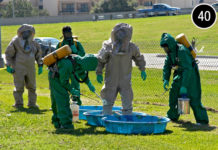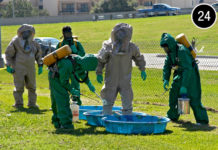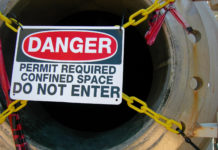EPA’s oil spill prevention program includes the Spill Prevention, Control, and Countermeasure (SPCC) and the Facility Response Plan (FRP) rules. The SPCC rule helps facilities prevent a discharge of oil into navigable waters or adjoining shorelines. The FRP rule requires certain facilities to submit a response plan and prepare to respond to a worst case oil discharge or threat of a discharge.
The goal of the SPCC regulation is to prevent oil from reaching navigable waters and adjoining shorelines, and to contain discharges of oil. The regulation requires facilities to develop and implement SPCC plans and establishes procedures, methods, and equipment requirements.
The EPA requires non-exempt facilities to prepare spill prevention, control and countermeasures (SPCC) plans. The applicable regulation and requirements are found in the Federal Oil Pollution Prevention Regulation – Title 40 CFR Part 112.
EPA Inspection
An EPA inspector will typically talk to field workers during an inspection to test the depth of their understanding of SPCC training at a facility. Employees who can’t speak to the specifics of the SPCC Plan at a facility could be deemed not trained by the EPA and could subject a facility to training violations and fines.
SPCC Employee Training Required for Compliance
The SPCC regulations require that all oil-handling personnel at SPCC-regulated facilities be trained. “Oil-handling personnel” is interpreted according to industry standards, but includes employees engaged in the operation and maintenance of oil storage containers or the operation of equipment related to storage containers and emergency response personnel. Oil-handling contractors at a facility must be trained as well as permanent employees.
SPCC training should include:
- An overview of the SPCC regulations and related pollution prevention regulations.
- Oil storage, transfer, and handling equipment on-site, including secondary containment structures.
- Secondary containment failures and what conditions require a spill report.
- Security measures on-site and description of potentially suspicious situations.
- Discharge procedure protocols and expectations of first responder actions.
Spill Prevention, Control and Countermeasure (SPCC) Overview
Spill Prevention, Control and Countermeasure (SPCC) Training – 2hrs
Description
The Spill Prevention, Control and Countermeasure (SPCC) training course covers oil industry federal and state regulations in the operation and maintenance of equipment to prevent discharges; discharge procedure protocols; applicable pollution control laws, rules, and regulations; general facility operations; and, the contents of the facility SPCC Plan.
This course provides an in-depth review of the federal requirements for Spill Prevention, Control and Countermeasure (SPCC) plans and a complete analysis of the development of SPCC rules and regulations. Development of SPCC plans requires detailed knowledge of the facility and the potential effects of any oil spill.
This course also provides information about the current SCPP regulations, contingency plans, facility response plans, and reporting requirements to help prevent oil spills that could reach navigable waters of the United States or adjoining shorelines.
Newly updated! Fully interactive training written by industry experts!
Hours: 2 hours
Pre-Requisites: None
Intended Audience
This course is intended for SPCC Plan employees including:
- Oil and petroleum industry engineers, workers, and personnel in the operation and maintenance of equipment to prevent discharges, discharge procedure protocols, and general facility operations.
Learning Objectives
At the conclusion of this course, you will be able to:
- Understand what the EPA’s Spill Prevention, Control, and Countermeasure rule is and why it was created.
- Which facilities and oils covered by the Spill Prevention, Control, and Countermeasure rule.
- Explain the most updated SPCC regulations.
- Prepare, review, and design SPCC Plans.
- Describe the importance of Emergency Management at facilities.
- Identify the substantial harm criteria.
- Design and implement Facility Response Plan and Integrated Contingency Plan.
Module Quizzes and Final Exam
All module quizzes require a score of 70% to proceed forward in the course. The exam will test your knowledge on information covered throughout the course. You must make a score of at least 70% to pass this course. You will be given up to three opportunities to pass each quiz and the final exam. If you do not pass after three tries, you will be locked out of this course will no longer be able to take your Outreach training in an online format.
Course Completion Certificate
Upon successful completion of the course, you will receive a printable certificate of completion which is accepted by OSHA as documentation of training.
SPCC Training Requirements
40 CFR Part 112.7(f) states:
- (1) At a minimum, train your oil-handling personnel in the operation and maintenance of equipment to prevent discharges; discharge procedure protocols; applicable pollution control laws, rules, and regulations; general facility operations; and, the contents of the facility SPCC Plan.
- (2) Designate a person at each applicable facility who is accountable for discharge prevention and who reports to facility management.
- (3) Schedule and conduct discharge prevention briefings for your oil-handling personnel at least once a year to assure adequate understanding of the SPCC Plan for that facility. Such briefings must highlight and describe known discharges as described in 40 CFR Part 112.1(b) or failures, malfunctioning components, and any recently developed precautionary measures.
Training should include understanding SPCC regulations and the facility’s plan; operating procedures that prevent oil spills; familiarity with the control measures that are in place to prevent oil spills reaching navigable waters; familiarity with emergency response procedures and mobilization of key personnel; awareness of evacuation routes and procedures; and reporting and record-keeping requirements.
Industry Terms
- Spill Prevention, Control and Countermeasure (SPCC)
- SPCC Requirements and Introduction
- SPCC Requirements for Bulk Storage Facilities
- SPCC Requirements for Marine Facilities
- SPCC Check List
- SPCC Inspections and Records
- SPCC Glossary of Terms
- SPCC Training
- SPCC Plan
- Federal Oil Pollution Prevention Regulation
- Title 40 CFR Part 112
- Facility Response Plan (FRP)
- EPA’s Oil Program
- Navigable Water
- Clean Water Act (CWA)
- Environmental Protection Agency (EPA)
Introduction to SPCC
Under the Spill Prevention, Control, and Countermeasure (SPCC) Regulation, “oil” is very widely defined and includes, but is not limited to, petroleum, fuel oil, oil refuse and sludge, animal fats, oils or greases, vegetable oils and greases and other oils and greases including synthetic and mineral oils.
A facility is subject to SPCC and required to prepare and implement an SPCC plan if it has an aggregate aboveground capacity greater than 1320 gallons in containers 55-gallons or greater or an underground capacity greater than 42,000 gallons and there is a reasonable expectation of a discharge into a navigable waterway or adjoining shoreline.
Plans must be reviewed and amended every five years or when facility information (personnel, oil sources, etc.) change. Elements of an SPCC plan include:
- Facility description and diagram
- Discharge calculations
- Secondary containment
- Likely spill path
- Site security
- Facility Inspections
- Container requirements
- Transfer procedures and equipment
- Training and recordkeeping requirements
- Management approval and plan certification
Spill Prevention, Control, and Countermeasure (SPCC) Regulation – 40 CFR 112
SPCC means Spill Prevention, Control and Countermeasure. The SPCC regulation is issued by the United States Environmental Protection Agency in 40 CFR 112. The SPCC regulation contains requirements for oil spill prevention, preparedness, and response to prevent oil discharges to navigable waters and adjoining shorelines.
Originally published in 1973 under the authority of §311 of the Clean Water Act, the Oil Pollution Prevention regulation sets forth requirements for: the prevention of, preparedness for, and response to oil discharges at specific non-transportation-related facilities.
The goal of 40 CFR 112 is to prevent oil from reaching navigable waters and adjoining shorelines, and to contain discharges of oil. The regulation requires these facilities to develop and implement Spill Prevention, Control, and Countermeasure (SPCC) Plans and establishes procedures, methods, and equipment requirements (Subparts A, B, and C).
In 1990, the Oil Pollution Act amended the Clean Water Act to require some oil storage facilities to prepare Facility Response Plans. On July 1, 1994, EPA finalized the revisions that direct facility owners or operators to prepare and submit plans for responding to a worst-case discharge of oil (Subpart D).
When a professional engineer certifies the spill prevention, control and countermeasures plan, it attests that the engineer is familiar with the requirements of 40 CFR 112, the engineer (or agent) has examined the facility and the plan is acceptable for that facility, the SPCC plan was prepared using good engineering practice (accounting for applicable industry standards) and in accordance with the requirements of 40 CFR 112, and that procedures for inspections and testing have been established.
What is Considered Oil Under SPCC?
It is also important to understand that oil, as it’s defined in the regulation, comes in many different forms including:
- Petroleum Based Oils – Gasoline, diesel fuel, motor, heating, aviation fuels, and hydraulic fluid;
- Non Petroleum Oils – Animal-based, vegetable, biofuels, seed, nut, fruit and kernel; and
- Oil Containing Products – Oil-based paints, thinners and inks, petroleum-based parts, and roofing tar
Spill Prevention, Control and Countermeasure (SPCC) Rule
- Regulatory Overview
- SPCC Applicability
- Qualified Facility Determination
- SPCC for Agriculture
- SPCC for the Upstream Sector
- Frequent Questions
SPCC Guidance and References
- SPCC Guidance for Regional Inspectors
- SPCC Reference Materials
- Secondary Containment Calculation Worksheets
- Tank Inspections
What facilities are subject to the SPCC regulation?
A facility is subject to the SPCC regulation if it meets the following three criteria:
- The facility must be non-transportation related;
- The facility must have a combined above-ground storage capacity greater than 1320 gallons or a buried storage capacity greater than 42,000 gallons; and
- There must be a reasonable potential for a discharge into or upon U.S. navigable waters or adjoining shorelines.
The SPCC rule applies to owners or operators of non-transportation related facilities who drill, produce, store, process, refine, transfer, distribute, use or consume oil or oil products that meet at least one of the capacity thresholds and have the potential to discharge oil to U.S. navigable waters or adjoining shorelines.
SPCC Plan Contents and Certification
A spill prevention, control and countermeasures plan must discuss how the facility meets the requirements for oil spill prevention and containment. The plan must detail in writing the equipment, workforce and steps required to prevent, control and mitigate an oil discharge. The general requirements for SPCC plans are located in 40 CFR 112.7.
Preparation of the SPCC plan is the responsibility of the facility owner or operator, or it can be prepared by an engineer or consultant, but it must be certified by a registered Professional Engineer. By certifying the SPCC plan, the Professional Engineer attests that:
- He/she is familiar with the requirements of 40 CFR Part 112;
- The engineer or their agent has visited and examined the facility;
- The plan has been prepared in accordance with good engineering practices;
- Procedures for required inspections and testing have been established; and
- The plan is adequate for the facility.
An SPCC Plan is unique to each facility, describing the particular configuration of the site ‘s Aboveground Storage Tanks (ASTs) and even the site’s Underground Storage Tanks (USTs) for sites exceeding 42,000 gallon capacity. However, common to all SPCC Plans is a listing of whether or not a site complies with the set of general requirements under 40 CFR 112 . The EPA periodically performs on-site inspections to assure compliance with the SPCC Plan regulations. Facilities are now required to submit information if in a 12 month period the site has had two or more releases of over 42 gallons or a single release of more than 1,000 gallons. The EPA will levy a fine for each item found to be in non-compliance. There is even a fine for failing to list within your SPCC Plan the areas of non-compliance at the site.
You must keep a copy of your SPCC Plan at your facility, if you operate the Aboveground Storage Tank (AST) facility more than four hours a day. If you operate the Above ground Storage Tank (AST) site less than four hours a day you may keep your SPCC Plan at the nearest field office. The EPA requires that a SPCC Plan be available to the EPA for on-site review and inspection during normal working hours.
Course Summary
Meets EPA Standards
Courses meets EPA standards for training requirements and provides compliance as required in 40 CFR Part 112.
- OSHA Accepted Provider
- Meets Latest EPA Standards
- Complies with 40 CFR Part 112
- Download certificate of completion
- Auto-bookmarking never lose place
- 100% Online – 24×7 Support
- Money Back Guarantee
Spill Prevention, Control and Countermeasure (SPCC) Training – 2hrs
Price: $45.00
24×7 Customer Support
Search the knowledge base, submit a support ticket, troubleshoot issues, recover passwords, chat, e-mail or call the customer support desk. We look forward to helping you.
Find support for any course – click here.
Phone: (877) 881-2235
OSHA Training Group Discounts
Get up to a 40% group discount! Enroll and train all your food safety employees with a group enrollment. Track progress, generate reports, and manage learners using a cloud-based platform. More Info
Key EPA SPCC Terms: epa, spcc, spill prevention,spill control,spill countermeasure, spcc training, spcc course, spcc plan, title 40 CFR Part 112, facility response plan, frs, EPA authorized provider, refresher annual.























